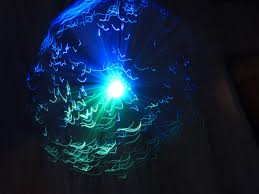Harnessing the Power: An In-depth Look at Kinetic Energy
Kinetic Energy: Imagine you’re kicking a football. When the ball is still, it doesn’t have much energy. But the moment your foot hits the ball and it starts moving, it gains energy - this is what we call kinetic energy. So, in simple words, kinetic energy is the energy that something has because it’s moving.
Why Understanding Kinetic Energy is Important:
Now, you might wonder why we need to understand kinetic energy. Well, it’s because kinetic energy is everywhere around us and plays a crucial role in our daily lives.
Let’s take the example of the car you drive. When your car is parked, it has no kinetic energy because it’s not moving. But when you start driving, your car gains kinetic energy. How faster you drive the car, the more kinetic energy your car have. This is why fast-moving cars cause more damage in accidents - they have more kinetic energy.
Let take Another example is wind turbines that you might have seen in fields or on hills. These giant fans convert the kinetic energy of the wind into electrical energy that we can use to power our homes and gadgets.
So, understanding kinetic energy helps us understand how things work around us - from cars and wind turbines to even the toys that children play with!
Let's understand in depth.!
Kinetic Energy : Kinetic energy is the energy that an object has because it’s moving. Think of it like this: if you’re riding a bicycle, the faster you pedal, the faster the bicycle moves. This is because you’re giving more kinetic energy to the bicycle. Similarly, if you’re pushing a heavy box, it’s harder to get it moving than a light box. This is because heavier objects need more kinetic energy to move. So, the amount of kinetic energy an object has depends on how heavy it is (its mass) and how fast it’s moving (its speed).
Work-Energy Theorem: Now, let’s talk about the work-energy theorem. This might be sound complicated, but it’s actually quite simple. ‘Work’ in physics means using force to move an object. For example, when you push a box, you’re doing work on the box. The work-energy theorem says that the work you do on an object is equal to the change in its kinetic energy.
Let’s go back to the bicycle example. When you start pedaling from a stop, you’re doing work on the bicycle to get it moving. This work increases the bicycle’s kinetic energy. If you pedal harder (do more work), the bicycle moves faster (has more kinetic energy). So, the work-energy theorem helps us understand how we can change an object’s kinetic energy by doing work on it.
Now, Let's know about type of energy:
Mechanical Energy : Mechanical energy is the energy that an object has because of its motion (kinetic energy) and its position (potential energy). For example, when you lift a book off a table, it gains potential energy. When you let go of the book, it falls and that potential energy is converted into kinetic energy.
Thermal Energy: Thermal energy is the kinetic energy of atoms and molecules. It’s what we commonly refer to as heat. For example, when you heat a pot of water on the stove, you’re increasing the thermal energy of the water molecules, making them move faster.
Electrical Energy: Electrical energy is caused by moving electrons. For example, when you turn on a light switch, electrons move through the wire and into the light bulb. This movement of electrons (electrical energy) lights up the bulb.
Radiant Energy : Radiant energy is electromagnetic energy that travels in waves. Light from the sun is a form of radiant energy. These light waves can travel through space and reach our planet, providing us with daylight.
Each of these types of kinetic energy plays a crucial role in our daily lives and in the natural world.
Wind Turbines: Wind turbines are a great example of harnessing kinetic energy. When the wind blows through wind turbine, it pushes against the blades of the turbine causing them to spin to posses energy. This spinning motion is kinetic energy. The turbine converts this kinetic energy into mechanical energy. Inside the turbine, there’s a generator that converts this mechanical energy into electrical energy that we can use to power our homes and businesses.
Hydroelectric Power Plants :Hydroelectric power plants work on a similar principle. They use the kinetic energy of flowing or falling water to generate electricity. When water flows or falls, it has kinetic energy because of its motion. In a hydroelectric power plant, this water flows past turbines causing them to spin, converting the kinetic energy of the water into mechanical energy. This mechanical energy is then converted into electrical energy by the generator.
Regenerative Brakes in Vehicles: Regenerative brakes in vehicles like electric cars and hybrids also harness kinetic energy. Normally when you brake, the kinetic energy of the moving car is wasted as it’s converted into heat by the brake pads. But regenerative brakes work differently. When you apply them, they use the vehicle’s kinetic energy to generate electricity instead of wasting it as heat. This electricity is then stored in the vehicle’s battery and can be used later, making these vehicles more efficient.
These are just a few examples of how we can harness kinetic energy in practical and beneficial ways.
let’s look at the future of kinetic energy:
Emerging Technologies and Research : There are many exciting developments in the field of kinetic energy. For example, researchers are exploring ways to harness the kinetic energy of ocean waves. Just like wind turbines use the wind’s kinetic energy, wave power systems can capture the kinetic energy of moving waves and convert it into electricity.
Another interesting area of research is in harnessing the kinetic energy of human movement. Imagine if every step you took could generate electricity! This could be particularly useful for powering wearable devices.
Sustainable and Renewable Energy Solutions Kinetic energy plays a crucial role in sustainable and renewable energy solutions. Unlike fossil fuels, which release harmful emissions when burned, kinetic energy is a clean source of power.
Harnessing kinetic energy doesn’t produce greenhouse gases or other pollutants. This makes it a key part of efforts to combat climate change and reduce air pollution.
Moreover, sources of kinetic energy like wind, water, and human movement are renewable - they don’t run out over time. This makes us feel a sustainable choice for meeting our energy needs now and in future.
The future of kinetic energy is very promising, with potential applications in many areas of our lives.
In our journey through the world of kinetic energy, we’ve discovered that it’s much more than just a scientific concept. It’s a fundamental part of our everyday lives, powering everything from our cars to the electricity in our homes. We’ve explored its various forms, including mechanical, thermal, sound, electrical, and radiant energy, each with its unique characteristics and applications.
We’ve also seen how we can harness kinetic energy in innovative ways, such as wind turbines and hydroelectric power plants. Even more exciting are the emerging technologies that promise to tap into new sources of kinetic energy, from ocean waves to human movement.
But perhaps the most important takeaway is the role of kinetic energy in creating sustainable and renewable energy solutions. As we grapple with the challenges of climate change and environmental conservation, kinetic energy offers a clean, green alternative to fossil fuels.
So as we look to the future, let’s continue to explore and harness the power of kinetic energy. Who knows what amazing discoveries and advancements lie ahead? The possibilities are as boundless as the energy that surrounds us. So keep learning, stay curious, and remember - every move we make is a testament to the incredible power of kinetic energy!








